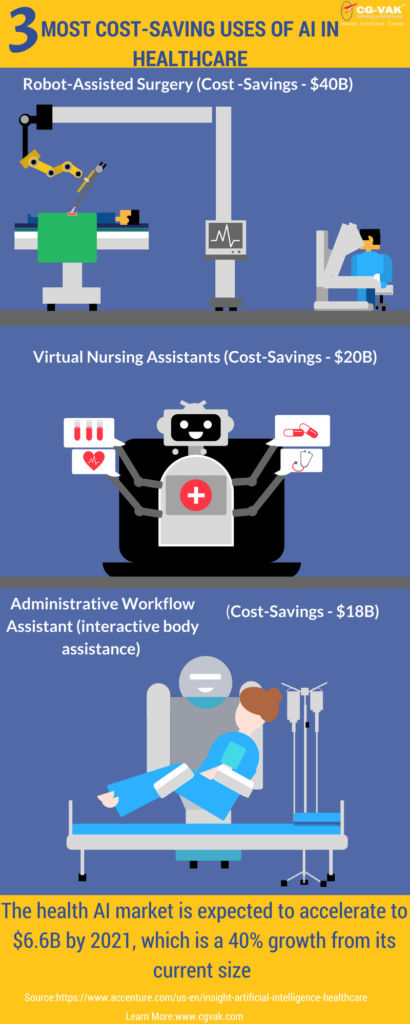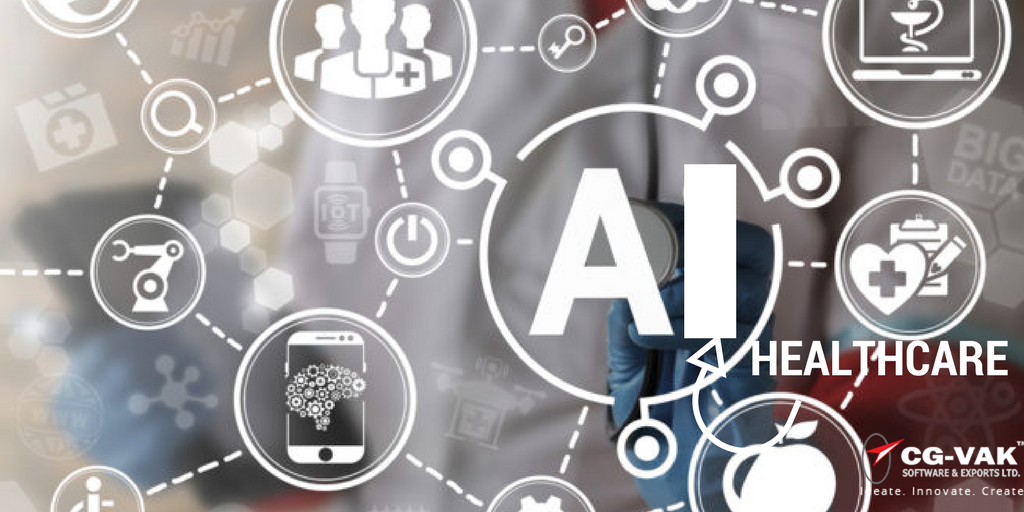The number of companies using artificial intelligence in healthcare has increased from less than 25 in 2012 to nearly 65 in 2016 and this growth keeps accelerating.
Growth is expected to accelerate with the AI healthcare market set to reach $6.6 billion by 2021, a 40 percent growth from now.
With that great insight, let’s take a look at the three most cost-saving uses of AI in healthcare.
Robot-Assisted Surgery
Robotic Technology is transforming the way surgeries are performed. Hi-Tech robotic platforms enable surgeons to perform more complex surgical procedures with only minimal incisions.
Utilising robotic technology to perform complex surgeries has its own advantages such as shorter hospitalization, reduced pain, and faster recovery time. Patients can now have a personalized surgical experience based on their specific diagnosis and anatomy.
Robotic surgery is definitely a breakthrough in various fields of healthcare including orthopedic surgeries. This innovative technology allows surgeons to position a joint replacement on a patient more accurately. It also assists in having a precise pre-operative planning to ensure extreme precision with bone cuts. Robot-assisted surgery offers more accuracy and precision that cannot be achieved with traditional manual techniques.
Another area where robot-assisted surgery is used is to treat oral, head, and neck disorders. Oral robotic surgery allows accurate removal of tumors of the mouth and throat with no major invasion.
This innovative procedure results in a dramatic improvement in treating head and neck cancer patients. Tumors are removed without affecting their normal activities like speech, swallowing, and other quality of life issues. Precision robotic arms and high-resolution cameras enable surgeons to work in narrow areas with no compromise on accuracy.
The Cardiothoracic field is another area which is immensely benefited by robot-assisted surgery. Here, minimally invasive robotic and video-assisted thoracoscopic surgery operations are done to treat lung cancer and adult cardiac issues.
Unlike the former surgery for lung cancer which acquired a big incision to remove part of the lung, robot-assisted surgery helps to operate with only five small incisions between the ribs without the need to open the inside of the chest.
No wonder in the future, robotic technology will continue to be an indispensable tool in the healthcare industry.

Virtual Nursing Assistants
These are AI enhanced healthcare applications used in providing nursing assistance to patients who are discharged after treatment. This feature offers advantages in terms of simplifying the provision of outpatient services, increasing the accuracy of monitoring patient status and compliance after they are discharged from the hospital, and offers huge cost savings to both the patient and the healthcare provider as well.
They are available as AI-enabled simple wearable devices and on smartphones. These virtual healthcare providers perform services like reminding patients to comply with their drug prescriptions, diet, and exercise plans as suggested by their physician, answering simple queries related to their treatment plan, and alerting healthcare providers about any abnormalities in the patient’s health like a sudden increase in blood pressure or a seizure.
Administrative Workflow Assistance
Today AI is used in the administrative process of the healthcare industry. AI is utilized in scheduling patient appointments. Patients who visit for the first time and those that visit for a review are scheduled in advance based on the physician’s time slots. Emergencies are included as add-ons to the physician schedule.
Considering the challenges in healthcare management, an AI-enhanced system optimizes the proper use of all resources. AI in patient care is both cost-effective and patient-friendly. This system is helpful to hospitals that witness a large number of patients on a daily basis.
This AI-empowered scheduling helps the hospital administration by optimizing the time of their doctors, nurses, and healthcare assistants.
AI-enhanced Robots are also used in other healthcare administration activities, thereby facilitating a more personalized patient care. Right from greeting patients at the front desk to offering interactive body assistance, AI-based robots are used for patients who need critical care. These robots can lift and move patients in and out of their beds, help patients to stand, and to turn them in order to keep bed sores at bay.
To learn more about the AI-enhanced healthcare applications, Talk to Us Today!
